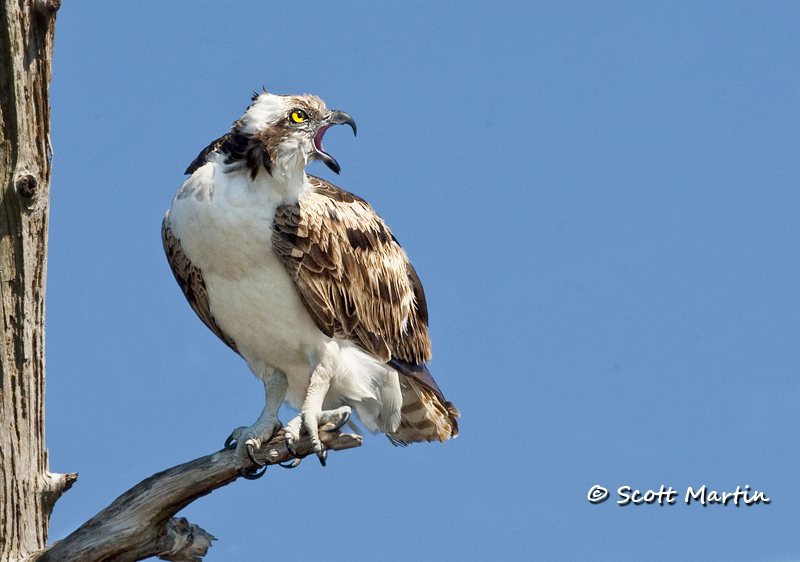
by Scott Martin Photography | Mar 27, 2011 | Birds, Blog, Raptors
We’ve just returned from eleven fabulous days in Florida where we enjoyed perfect weather, great light and now have many gigs of CF cards filled and waiting to be processed.
While in Florida our son Jeff was engaged to Ellesse and they are getting married this October. Our daughter Lindsay and her fiancé Cam are getting married this summer so we are looking forward to a fun filled and busy few months ahead.
This post will be short as I haven’t had time to process many images yet and I’m experimenting with the WordPress iPhone app to make this post, which is a first for me. Stay tuned as there are lots of upcoming posts of Florida birds.
Here is an Osprey taken at the Viera Wetlands, on the Space Coast of Florida. It’s a Mecca for bird photographers and if you have never been there you need to put it on your list of places to visit.

43.919428-78.915892
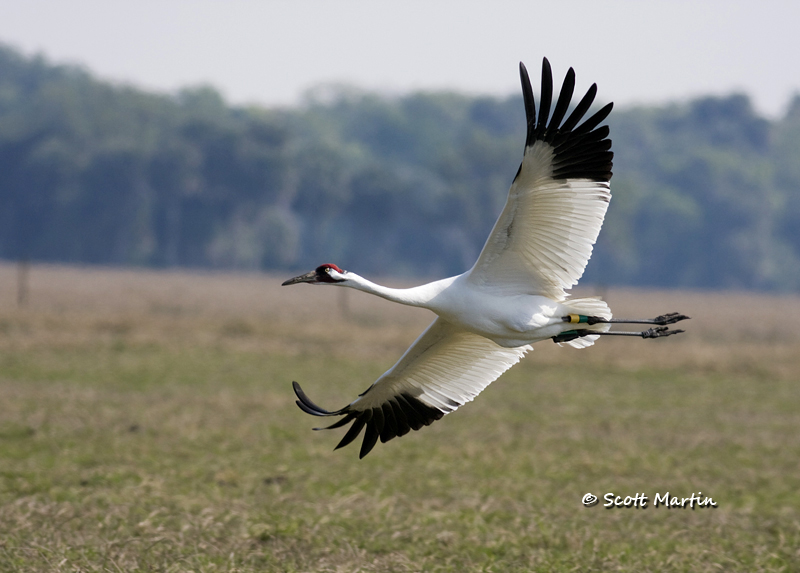
by Scott Martin Photography | Mar 3, 2011 | Birds, Blog, Raptors, Shore Birds & Waterfowl
For many years our family has joined the March Break Exodus and headed to Florida. It’s hard to believe that time of the year has arrived again! For a bird photographer March is a great time to be in Florida as many of the birds are nesting, which means they are also in their colourful breeding plumage.
Whenever you travel and are looking for birds, a great tip is to look through the yellow pages and find someone listed who makes custom bird houses and give them a call. My experience is that they will not only know where the birds are but also be willing to tell you! This is exactly what I did a few years ago and when the gentleman on the phone asked what types of birds I was looking for, my somewhat tongue-in-cheek reply was “Snail Kites and Whooping Cranes”. I was surprised when he answered “No problem, here’s exactly where you need to look”. Even more surprised were my wife and I when after driving about forty-five minutes to the location suggested we were greeted by four Whooping Cranes flying directly over top of our heads. It was an amazing sight which was followed by about an hour of watching two pairs of Whooping Cranes. After the Cranes moved on to another location we walked down to the shore line of Lake Kissimmee and within ten minutes a Snail Kite, clutching an Apple Snail flew by and offered the perfect photographic opportunity. We have gone back to the same location every year since and you guessed it, have not seen any Whooping Cranes or Snail Kites since!
Here is one of the Whooping Cranes from that day, taken hand-held with a Canon 40D and EF 400mm f/5.6 L lens.

Whooping Cranes are an endangered species and the rarest bird in North America with ~400 known wild birds. They are also North America’s tallest bird standing about six feet high with an eight foot wing span. The following image shows the relative size of the Whooping Crane….and no those are not miniature cows in the foreground 🙂
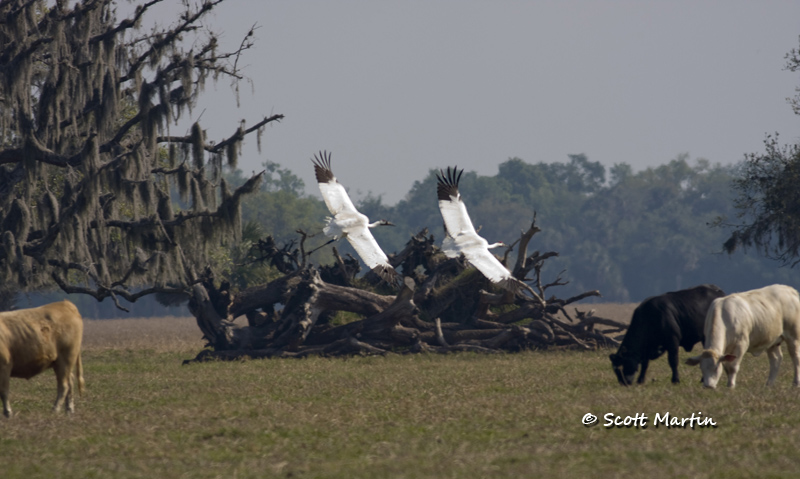
The Snail Kite is the rarest North American Raptor and is a locally endangered species in Florida where it is estimated there are about 400 breeding pairs. Their primary diet is the Apple Snail and they use their talons to deftly remove the snails from plant stems just below the water surface. They are so good at this process that they rarely get their feathers wet in the process.
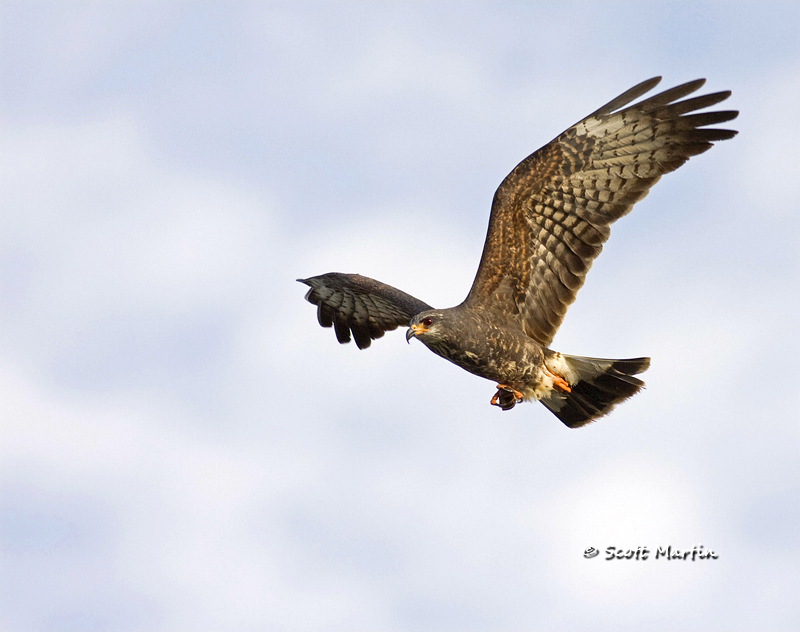
This year our goal is to photograph Snail Kites and Eagles while in Florida and who knows, perhaps even another Whooping Crane.
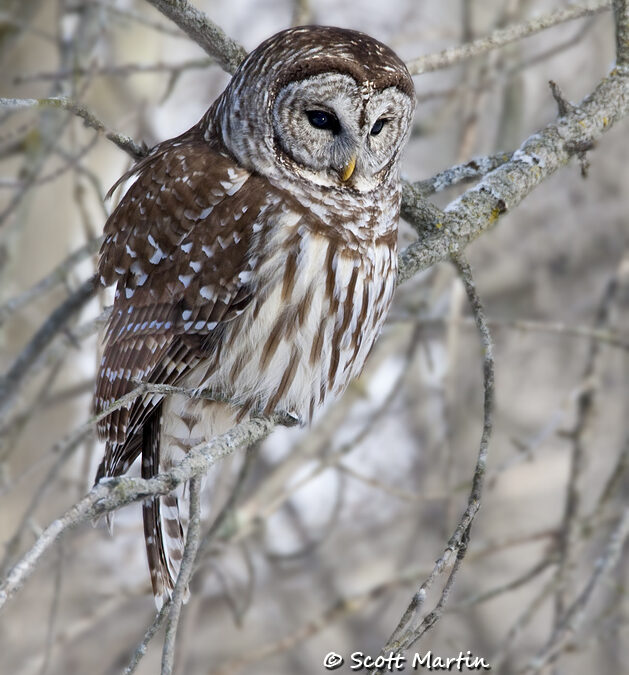
by Scott Martin Photography | Feb 18, 2011 | Birds, Blog, Raptors
Of the eleven different Owl species that are seen in Ontario, the Barred Owl is probably my favourite for any number of reasons; they are somewhat active during the day, they move around regularly providing opportunities to see them in flight, they can be very noisy and provide lots of interesting sounds, and they are photogenic.
Barred Owls have very dark eyes (unlike any other North American Owl save the Barn Owl) and are a large bird up to 62 cm in length and a wingspan of 1-1.3 metres making the larger than a Red Tailed Hawk with a wingspan greater than a crow. Barred Owls have fairly weak talons and therefore prey on smaller animals such as mice, voles and squirrels although they will also eat small amphibians and birds as well. Barred Owls nest in natural tree cavities where the female lays 2-3 eggs requiring about thirty days to incubate. The female remains on the eggs for all of the incubation period and the male brings her food.
Although the Barred Owl is one of the more popular Ontario Owls they are still uncommon and their numbers in Southern Ontario are on the decline as urbanization destroys the deciduous woodland environment they require to thrive.
We are fortunate to have a Barred Owl pair not too far from home and it was a pleasure for my friend Don & I to spend a while with one of them this past Saturday morning. At one point as the Owl relocated to another hunting area he flew just above eye level within about twenty feet of us which was amazing to see. They are virtually silent in flight and maneuver effortlessly through the dense forest cover for such a large bird.
The following images were taken at 700mm (500/4 + 1.4x TC) using a mono-pod for support.
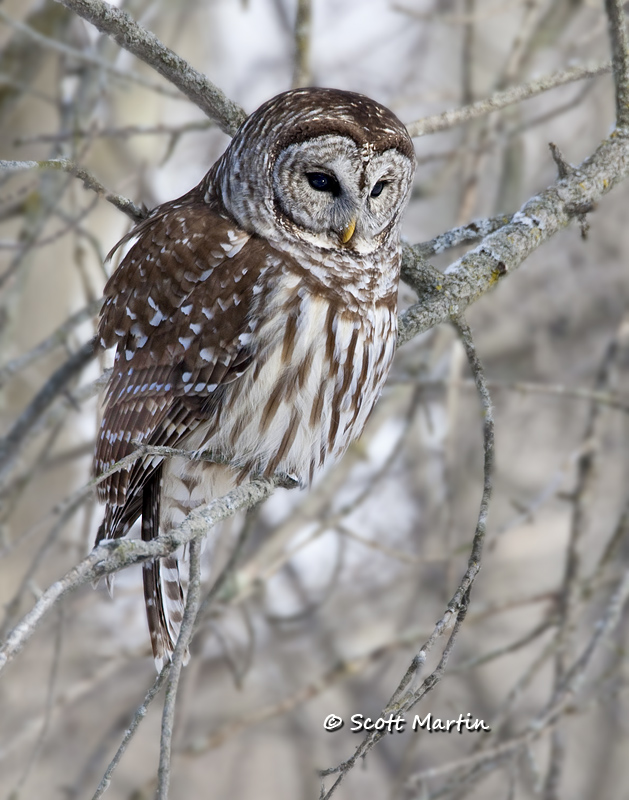
.
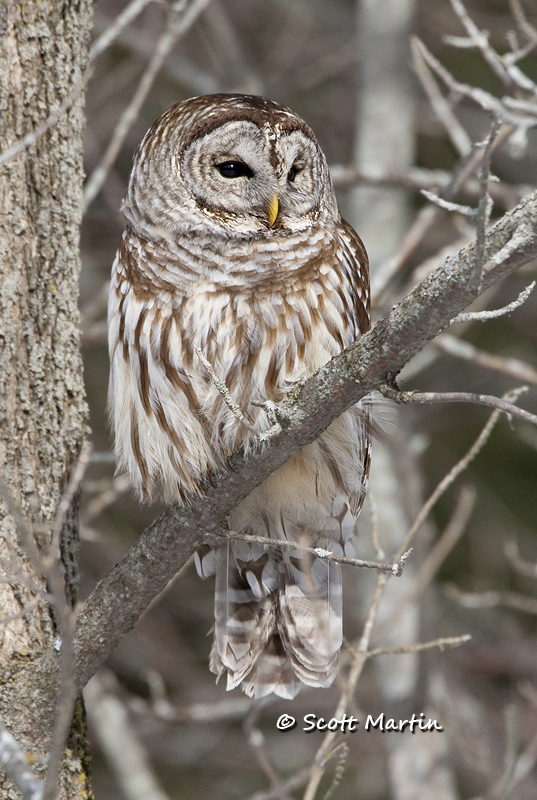
.
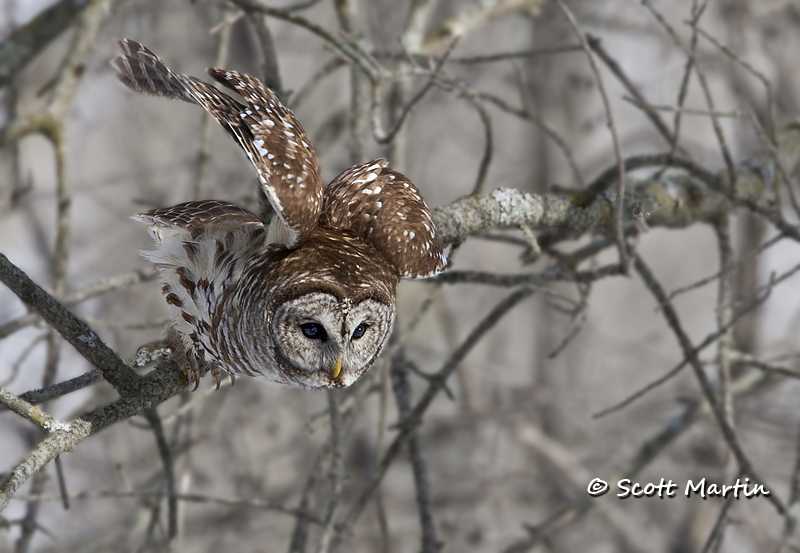
More Owls can be viewed by clicking the Owls Gallery. Please feel free to leave a comment as they are always appreciated, as are Tweets to your followers if you are so inclined….. just click the little icon below 🙂
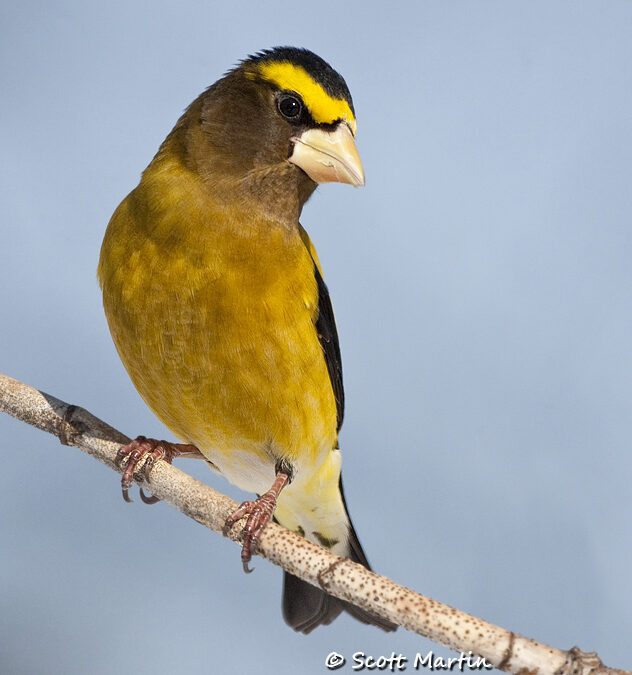
by Scott Martin Photography | Feb 17, 2011 | Birds, Blog, Raptors, Sparrows
After making a most enjoyable return trip to the Kawartha Lakes Region of Ontario, I was able to get some acceptable images of male Evening Grosbeaks. The bright white secondary wing feathers on males creates a photographic challenge as the tendency is to over expose the whites removing all detail and commonly referred to as “blowing out the whites”. Blown whites are a huge faux pas in photography however avoiding them completely is often very difficult if not impossible. They occur very easily when shooting birds with contrasting dark & light colours, such as Black Capped Chickadees, Buffle Head Ducks or in this case Evening Grosbeaks. The methods used to lessen the likelihood of blowing out the whites are many however they all involve underexposing the recommendations from what the camera meter is suggesting (unless you are able to spot meter on the whites alone in the viewfinder). Creating an image with the whites properly exposed darkens the shadows and typically underexposes the rest of the scene, however this can be accommodated for quite easily in post processing, especially if you are shooting in RAW. Remember you can always get more detail back from the shadows & underexposed areas of an image but once you blow the whites you can never reclaim any detail with Photoshop.
Here are some male Evening Grosbeaks
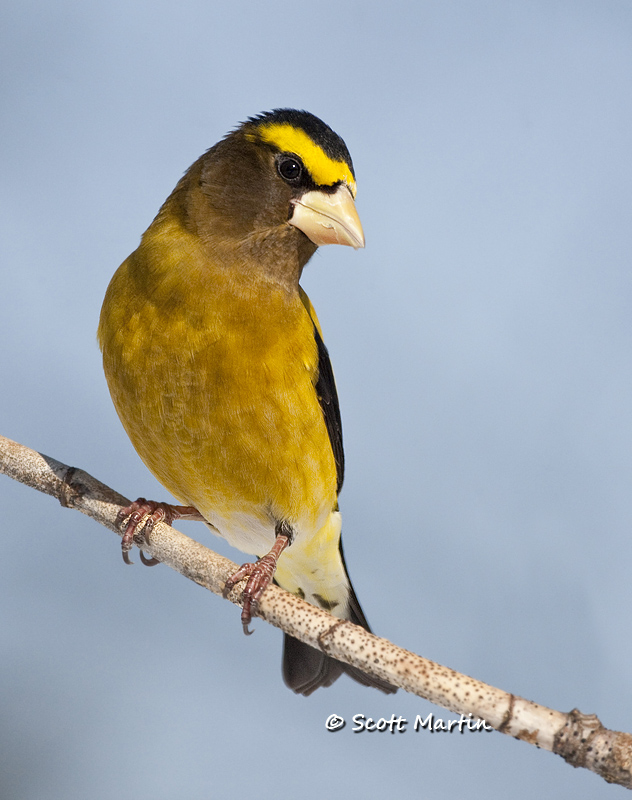
.
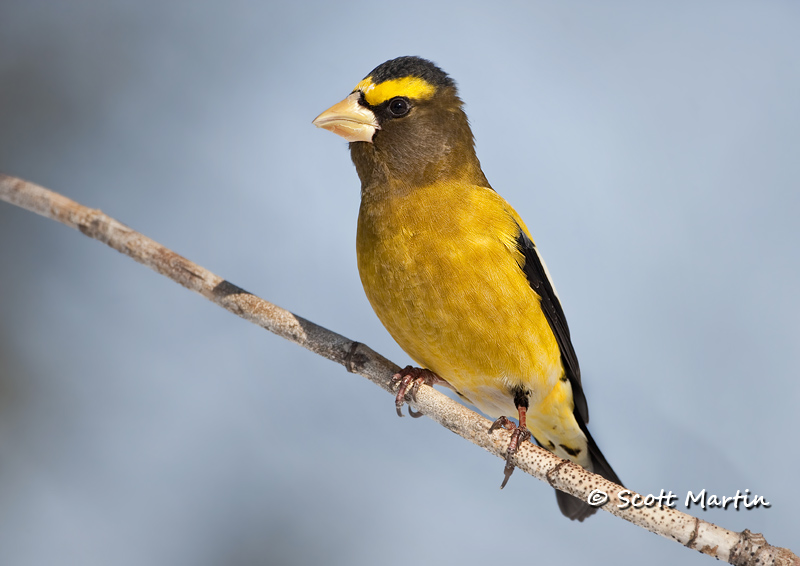
.

…..and finally another female.

Click on the Evening Grosbeaks Blog to learn more about Evening Grosbeaks and on the Grosbeaks Gallery to see more images.
On an unrelated and unfortunate note, it was reported on Valentine’s Day, that a Northern Hawk Owl wintering in the Kawartha Lakes Region was struck and killed by passing car while the owl was hunting for food. Bob Bowles, noted Orillia Naturalist, provided the following report:
“The Northern Hawk Owl that was found during our Carden Alvar CBC on January 2, 2011 has been hunting in the wetland near the junction of Road 46 from Simcoe and Road 6 from City Of Kawartha Lakes. Several birders have reported this bird this winter during the month of January and into February. This morning it was found dead on the side of the road between Avery Point Road and the junction where is was first reported. It had a Meadow Vole clutched in its right talon and had a broken left wing. We can only assume that it was hit by a passing vehicle as it hunted along the roadway.
For the last three years, a Northern Hawk Owl has been observed during winter each year just after Christmas in most cases near Orillia. All have ended up the same way being found dead after being hit by a passing vehicle. This bird had been observed a few weeks ago hunting near the road and flying low over the road barely being missed by passing cars. I was hoping that this one would make it through the winter to return north in the spring but it didn’t make it”.
Here is a shot of the Northern Hawk Owl taken last month while it perched in a tree alongside County Road 46. Others can be seen in the Owl Gallery
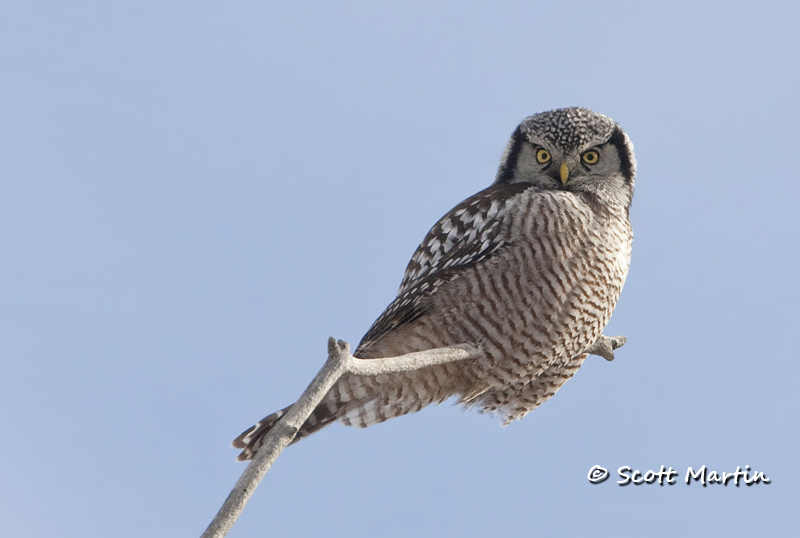
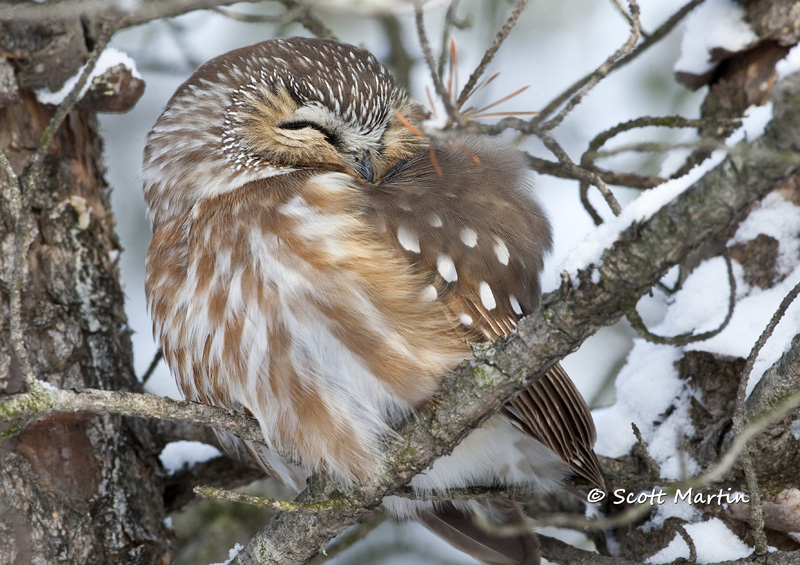
by Scott Martin Photography | Jan 26, 2011 | Birds, Blog, Raptors
This past Friday my good friend Arni picked me up at 6:00 a.m. and we headed out for a day of birding and photography around Eastern Ontario. I thought six was early but Arni left his place at four! The general goal for the day was to find two different Boreal species, the Boreal Owl and the Boreal Chickadee. Boreal refers to the Boreal Forest which encompasses the Northern sections of the Northern Hemisphere, however the Boreal Forest does extend southwards in parts of Ontario, including Algonquin Park. Severe weather in the North often displaces Boreal species southward in the winter months and this is what brings the odd Boreal Owl & Boreal Chickadee to South Eastern Ontario at this time of the year.
Unfortunately we didn’t find either of the birds we were looking for but nevertheless it was a fabulous day, lots of fun and we still have two birds to look for again on the next excursion. We did however find a couple of Saw Whet Owls and one Long Eared Owl plus a number of raptors including American Bald Eagles, Red Tailed Hawks and Rough Legged Hawks. We also saw a number of winter water fowl, the highlight being a flock of several hundred Long Tailed Ducks.
The little Saw Whet Owl looked like Sleeping Beauty, well hidden deep in a Jack Pine tree.

The feather detail around the eye and facial disc is truly amazing.
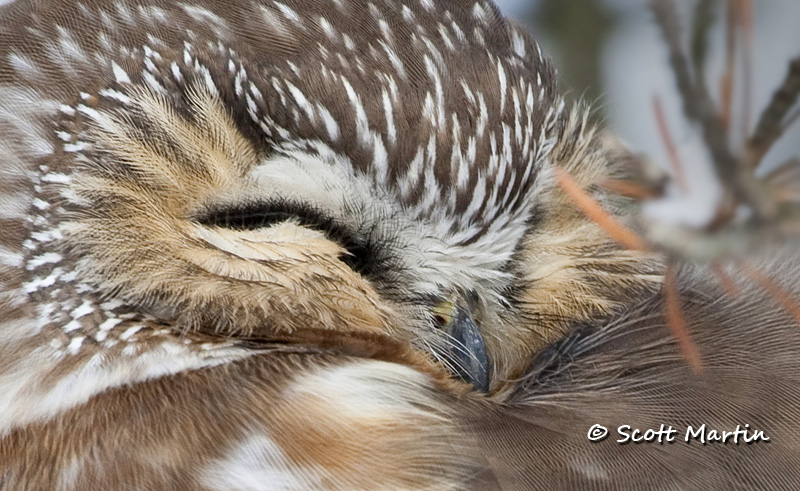
Although not a great image, this Red Tailed Hawk let us get fairly close, even though he was perched on the top of a hydro pole.
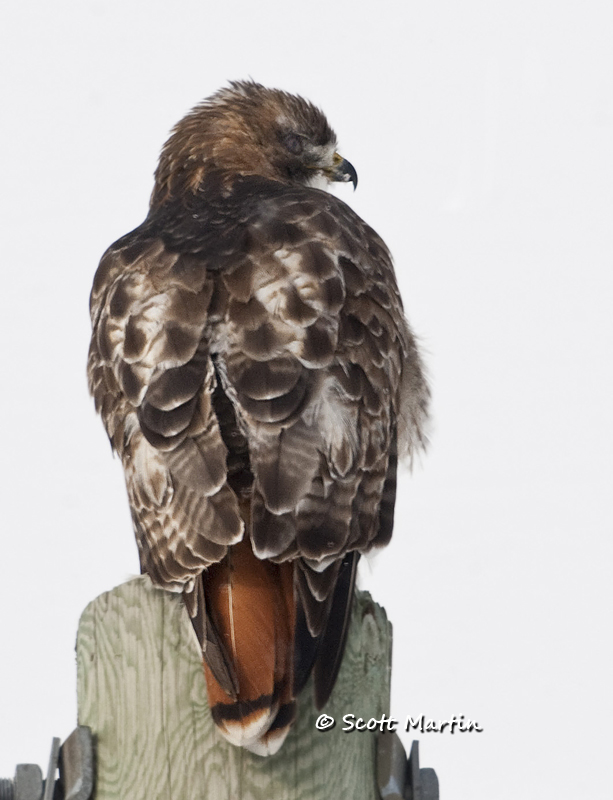
More owl images can be seen in the Owls Gallery and you can find more Red Tailed Hawks in the Hawks, Falcons & Kites Gallery
This week I made a Facebook page for
Scott Martin Photography which you can see by clicking on the Facebook Icon at the top of the right side panel of the blog. If you are on Facebook please follow the SMP page by clicking on the ‘Like’ page button from your Facebook home page. One of the purposes of having an SMP Facebook page is to allow for discussion on various photography related topics. If you have any questions or topics for discussion please feel free to post it on the SMP Facebook page and we will be glad to address your comments, ideas or concerns.
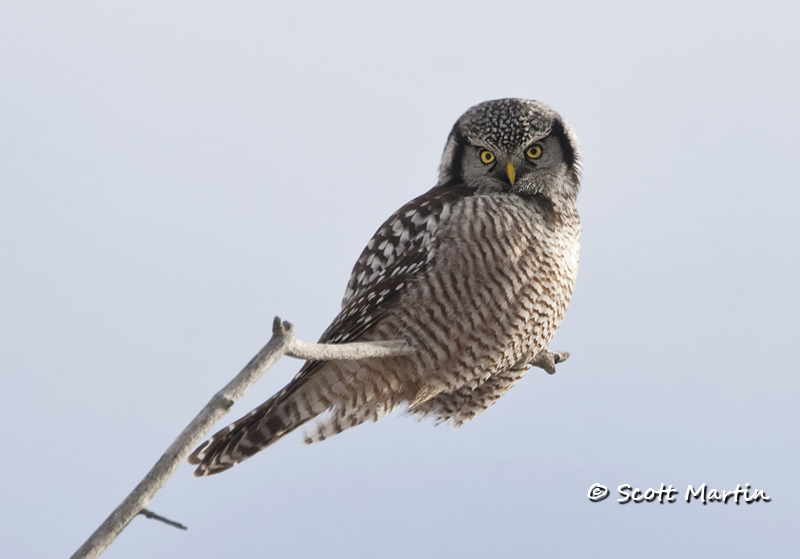
by Scott Martin Photography | Jan 15, 2011 | Blog, Raptors
Happy New Year to all and I trust you have enjoyed a terrific Christmas season. My photography New Years resolution was to get some decent shots of three owl species that we don’t often see in Southern Ontario…..a Snowy Owl, a Great Gray Owl and a Northern Hawk Owl. Fortunately I was able to cross the Northern Hawk Owl off the list after driving about an hour north of Oshawa last Friday morning. Leaving before sunrise I met up with my friend Arni – make sure you check out his website Nature’s Wonders in Pixels – and we were able to watch and photograph a Northern Hawk Owl for three or four hours.
The Northern Hawk Owl is a medium-sized owl (~16″ long with a 28″ wingspan) that typically lives in the Boreal Forest regions of Northern Canada where it feeds primarily on small mammals like mice and voles, however in the winter months when food becomes scarce they will also eat other birds. Although Northern Hawk Owls are non-migratory the lack of food availability during the winter months in the north displaces the owls southward which is what brings a few them to Southern Ontario this time of the year.
Northern Hawk Owls have amazing eye sight, being able to spot prey up to 800 meters away. They can also find and seize mice & voles under one foot of snow, which is truly remarkable. Northern Hawk Owls are monogamous and usually nest in tree cavities although they will take over nests of other large birds. They don’t construct their own nests. Both parents look after feeding the young however the male feeds the female for the week before she lays her eggs and for the 25-30 days she incubates them.
The Hawk Owl gets its name because it flies much like a hawk, low with quick shallow wing beats and gliding. It can also hover. Interestingly, they have the longest tails of any North American owl which gives them the look of a hawk.
Perhaps because Northern Hawk Owls live in the north and don’t see people very often, they show little fear of man and are surprisingly approachable. They seem to be very inquisitive and are birds with many different facial expressions which I’ve tried to illustrate in the following images.

.

.
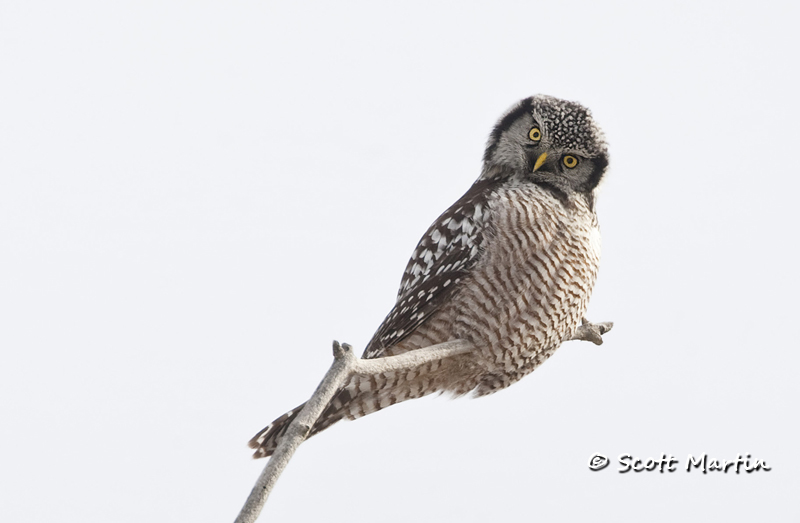
.
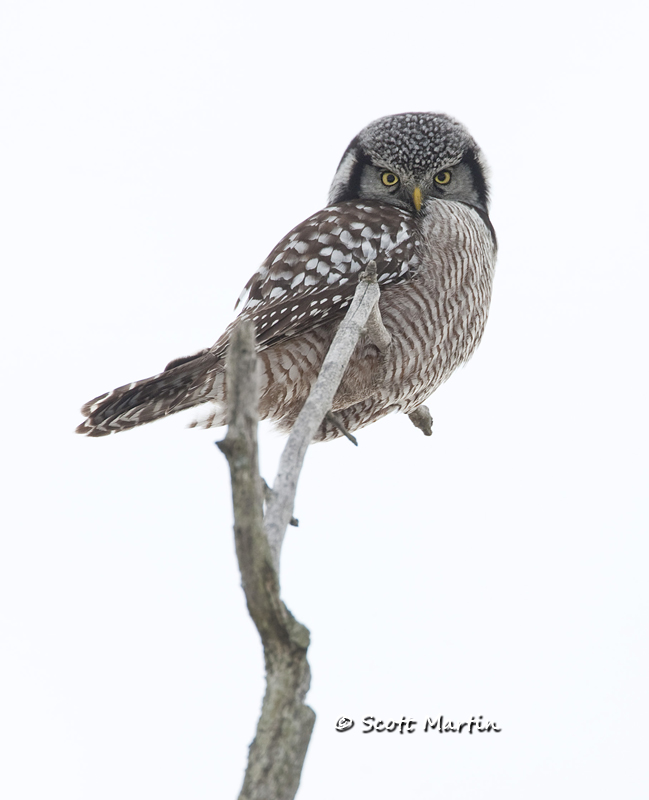
.
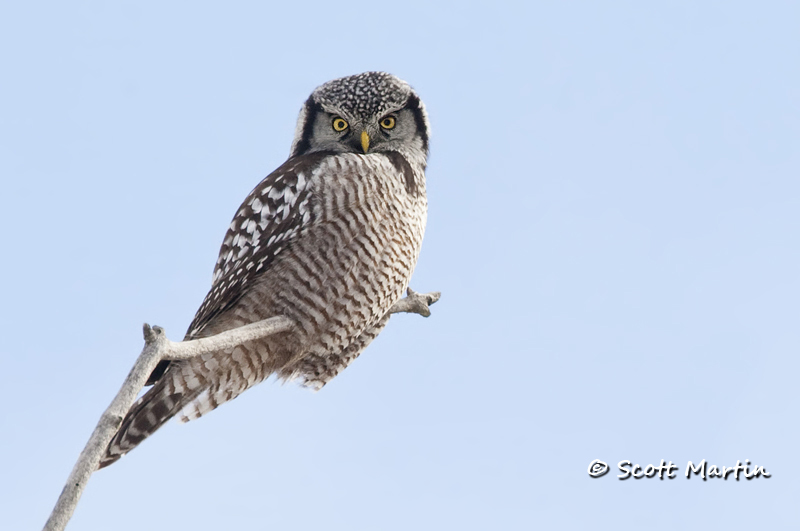
All of these images were taken with a 500/f4 lens with a 1.4 x TC for an effective focal length of 700mm. If you are interested in seeing other owls you can find them in the Owl Gallery


























Follow Scott Martin Photography